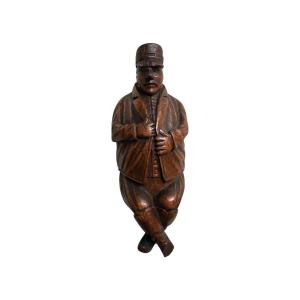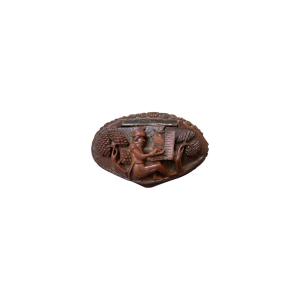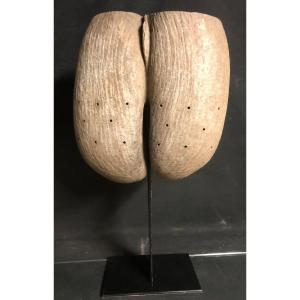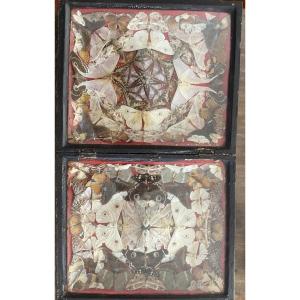Mid-19th century
Europe – likely France (Alpine or Massif Central region)
Private collection, Auvergne – Haute-Loire
Long animal bone (possibly human?) engraved with cabalistic signs drawn from the Grimoire of Pope Honorius, used in the context of inverted Christian ritual magic. The object bears a series of symbolic inscriptions across both sides, including clearly identifiable elements: a radiant sun with a human face, triple crosses, cryptic letters, and stylised anthropomorphic figures.
This type of object is linked to operative magical practices described in the clandestine grimoires circulating throughout Europe at the end of the Ancien Régime. More specifically, the iconography directly follows Plate II, Figure 2 of the Lyon edition of the Grimoire of Pope Honorius (c. 1760–1820), in which the officiant inscribes magical signs onto a sacred medium (paper, parchment, or bone) after sacrificing a black rooster and performing the Mass of Angels. The solar figures and cabalistic letters reproduced here match those in the text exactly.
The analysis of this object required several months of comparative research across rare editions of the Grimoire of Pope Honorius (Lyon, 1800), the Clavicula Salomonis, and the Petit Albert, in order to trace the exact graphemes. The iconographic correspondences strongly reinforce the authenticity of the magical vocabulary employed.
The bone displays a uniform patina, areas of blackening, and incised symbols highlighted with soot or ink. Signs of wear consistent with prolonged handling are also visible. Each symbol is engraved with intention, devoid of decorative logic — this is a language of power, structured according to a magical syntax. The choice of bone over parchment evokes a deeper sense of transgression and archaism, aligning with necromantic or learned rural witchcraft traditions.
Several possible uses may be considered: a talisman of invocation designed to command spirits during solitary rituals; a protective seal hidden in a secret location (such as a loft or domestic altar); or a personal object of magical dominion, held or buried during a black mass. The linear arrangement of the script and the presence of a central solar symbol suggest a silent formulation — a mute command intended to act upon the summoned entities.
This type of object, scarcely documented in public collections, belongs to a marginal yet codified magical culture, situated at the crossroads of subverted religion, rural esotericism, and individual conjuration. It should be understood as tangible evidence of the subterranean persistence of magical rites in Christian contexts at the turn of the 19th century.
References:
– Grimoire of Pope Honorius, Lyon ed., c. 1800, plates II & III
– J.-B. Pitois, La magie et les sciences occultes, 1870
– Claude Lecouteux, Dictionary of Medieval Magic, 2020
– Owen Davies, Grimoires: A History of Magic Books, 2009
– Comparative studies on French and German rural magical objects
Note: ancient ritual object made of animal bone, sold exclusively for collection, historical research, or private display. Not decorative. Rare.
Dimensions:
Length: 15 cm
ALL SHIPMENTS ARE HANDLED VIA DHL EXPRESS ONLY!


















































 Le Magazine de PROANTIC
Le Magazine de PROANTIC TRÉSORS Magazine
TRÉSORS Magazine Rivista Artiquariato
Rivista Artiquariato